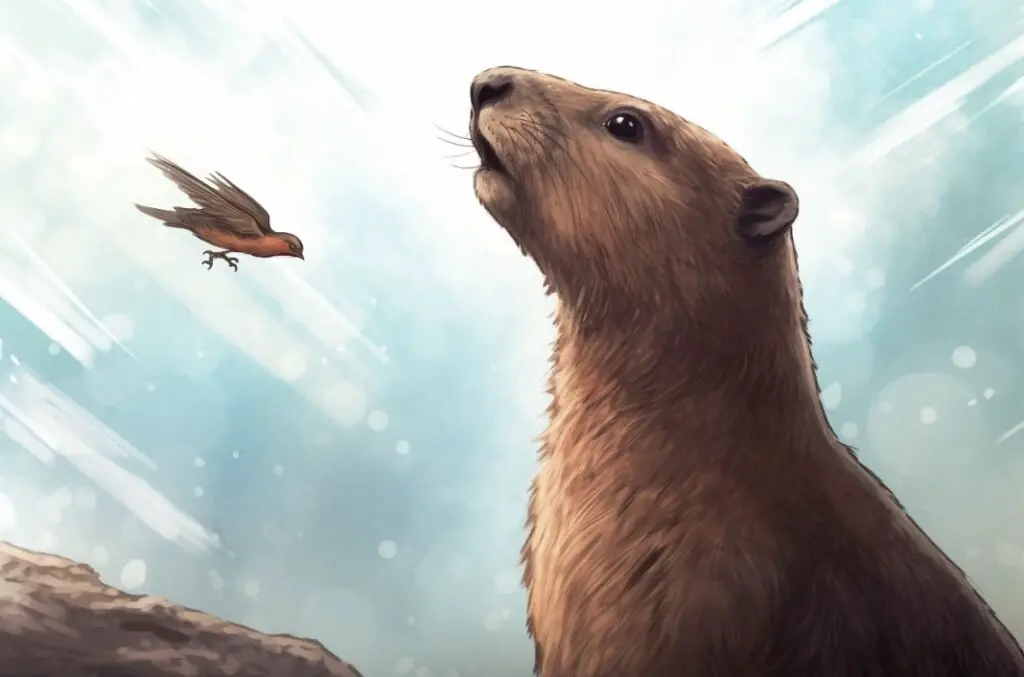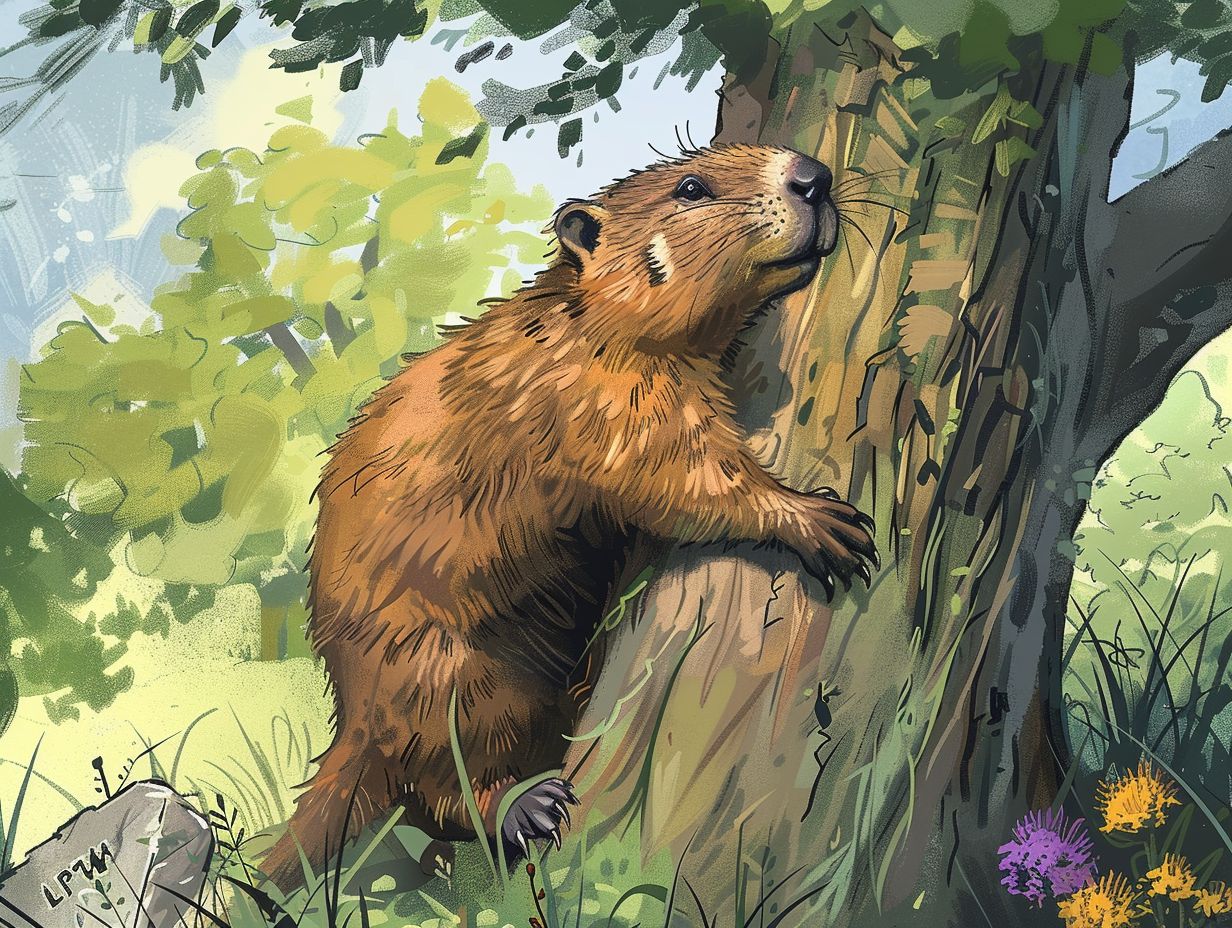Nope, they have fairly good vision in fact!
Groundhogs, also known as woodchucks or whistle pigs, are large rodents native to North America. They belong to the family Sciuridae and are a type of marmot, closely related to squirrels.
Groundhogs are known for being burrowers, creating extensive tunnel systems where they sleep, rear their young, and hibernate during winter. They are also famous for their alleged weather prediction abilities on Groundhog Day, February 2nd.
Physical Characteristics
Groundhogs are robust animals, measuring about 16 to 26 inches in length (including their bushy tail) and weighing between 4 to 9 pounds. They have short, powerful limbs with curved claws that are well-suited for digging. Groundhogs have dense fur that ranges from grayish-brown to reddish-brown in color.
Groundhog Vision
Groundhogs have well-developed eyesight, which is essential for their survival.
They have large eyes that are positioned on the sides of their head, giving them a wide field of view. This placement helps them to detect predators, such as hawks, foxes, and coyotes, from a distance.

Their eyes are also situated high on their head so that they can see while sticking their head out of their burrow.
Groundhog Diet
Groundhogs are primarily herbivores, feeding on a variety of plants, such as grasses, clover, dandelions, and alfalfa. They also eat fruits, vegetables, and occasionally insects. Their sharp incisors and strong jaw muscles allow them to efficiently bite and chew their food.
Groundhog Behavior
Groundhogs are diurnal animals, meaning they are active during the day and sleep at night. They are most active in the early morning and late afternoon when they forage for food. They tend to be solitary creatures, with the exception of the mating season and when raising their young. Groundhogs are known for their ability to whistle, which they use as an alarm call to warn other groundhogs of potential danger.
Groundhog Hibernation
During the winter months, groundhogs enter a state of hibernation, which is a deep, prolonged sleep that allows them to conserve energy. They will prepare for hibernation by digging a separate burrow used solely for this purpose. Before entering hibernation, groundhogs will eat large amounts of food to build up their fat reserves. During hibernation, their body temperature, heart rate, and breathing rate all decrease significantly.
Groundhog Mating and Reproduction
Groundhogs mate in the early spring, shortly after emerging from hibernation. The female gives birth to a litter of 2 to 6 pups after a gestation period of about 32 days. The young groundhogs, called kits or chucklings, are born blind and hairless. They will develop their vision and fur within a few weeks and will stay with their mother for about two months before venturing off on their own.
Groundhog Day
Groundhog Day is a popular tradition in the United States and Canada, celebrated on February 2nd each year. According to the folklore, if a groundhog emerges from its burrow on this day and sees its shadow, it will retreat back into its burrow, signaling six more weeks of winter. If the groundhog does not see its shadow, it is said to predict an early spring.
Human Interactions with Groundhogs
Groundhogs have been known to cause damage to gardens and crops due to their burrowing and foraging habits. They can also undermine building foundations and create tripping hazards with their burrow entrances. In some cases, groundhogs are considered pests and may be trapped or removed to prevent further damage.
Conclusion
In conclusion, groundhogs are not blind. They have well-developed eyesight that plays a crucial role in their survival. Here are ten quick facts about groundhogs:
1.Groundhogs are rodents native to North America.
2. They are also known as woodchucks or whistle pigs.
3.Groundhogs have well-developed eyesight.
4. They are primarily herbivores, feeding on a variety of plants.
5.Groundhogs are diurnal animals, active during the day.
6. They hibernate during the winter months to conserve energy.
7.Groundhogs mate in the early spring, giving birth to 2 to 6 pups.
8. Groundhog Day is a popular tradition celebrated on February 2nd.
9.Groundhogs can cause damage to gardens, crops, and building foundations.
10. They are not considered endangered and have a stable population.
FAQs
Is it OK to let a groundhog live in your yard?
It is generally safe and acceptable to allow a groundhog to live in your yard as long as it is not causing damage to your property or posing a threat to human or pet safety. However, it is important to keep in mind that groundhogs are wild animals and should be observed from a safe distance.
Can a groundhog hurt you?
Groundhogs are not typically aggressive towards humans and will usually try to flee if they feel threatened. However, they do have sharp teeth and claws and can bite or scratch if cornered or provoked. It is best to give groundhogs their space and avoid approaching or handling them.
Should I leave the groundhog in my yard?
If the groundhog is not causing any harm or damage to your property, it is generally recommended to leave it alone and let it continue to live in its natural habitat. If it is causing damage or posing a threat to your safety, it may be necessary to contact a professional for assistance in relocating the animal.
Are groundhogs aggressive to humans?
Groundhogs are generally not aggressive towards humans, but they may become defensive if they feel threatened or cornered. It is important to give them space and avoid approaching them, especially during mating season or when they have young.
Can a groundhog hurt a dog?
Yes, a groundhog can potentially hurt a dog if it feels threatened or cornered. Groundhogs have sharp teeth and claws that they can use to defend themselves. Additionally, groundhogs can carry diseases that can be transmitted to dogs through bites or scratches. It is important to keep dogs away from groundhogs and other wild animals to prevent any potential harm.
Can groundhogs see at night?
Yes, groundhogs have good night vision and can see in low light conditions.




